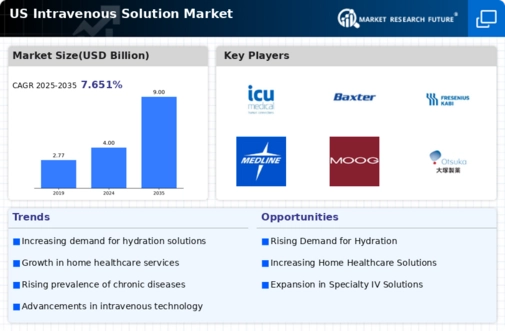Rising Geriatric Population
the intravenous solution market is growing due to the rising geriatric population in the US. As individuals age, they often experience multiple health issues that require medical intervention, including the administration of intravenous therapies. The US Census Bureau projects that by 2030, all baby boomers will be over 65 years old, leading to an increased demand for healthcare services, including intravenous solutions. This demographic shift suggests that healthcare providers will need to adapt their services to meet the needs of older patients, thereby driving the intravenous solution market. The complexity of managing health in older adults often necessitates the use of intravenous solutions for hydration, nutrition, and medication delivery.
Focus on Patient-Centric Care
The intravenous solution market is increasingly influenced by the focus on patient-centric care within the US healthcare system. Healthcare providers are prioritizing personalized treatment plans that cater to individual patient needs, which often includes the use of intravenous solutions for tailored medication delivery. This shift towards patient-centered approaches is likely to drive demand for a variety of intravenous solutions, as providers seek to optimize therapeutic outcomes. Additionally, the emphasis on improving patient experiences and satisfaction may lead to the development of new formulations and delivery methods in the intravenous solution market. As healthcare continues to evolve, the integration of patient preferences into treatment protocols will likely shape the future landscape of intravenous solutions.
Growth in Surgical Procedures
The intravenous solution market is significantly influenced by the growth in surgical procedures across various medical specialties. As the US healthcare system continues to advance, the number of surgeries performed annually is on the rise. The American College of Surgeons reports that millions of surgical procedures are conducted each year, necessitating the use of intravenous solutions for anesthesia, hydration, and medication administration. This increasing volume of surgeries indicates a robust demand for intravenous solutions, as they are essential for patient safety and recovery. Furthermore, the trend towards minimally invasive surgeries may also contribute to the growth of the intravenous solution market, as these procedures often require precise fluid management.
Advancements in IV Delivery Systems
is benefiting from advancements in IV delivery systems, which enhance the efficiency and safety of intravenous therapy. Innovations such as smart infusion pumps and automated IV systems are being integrated into healthcare settings, allowing for more precise dosing and monitoring of patients. These technological improvements not only improve patient outcomes but also streamline the workflow for healthcare providers. The adoption of these advanced systems is likely to increase the demand for intravenous solutions, as they require compatible products for effective use. As hospitals and clinics invest in modernizing their equipment, the intravenous solution market is expected to expand in response to these advancements.
Increasing Prevalence of Chronic Diseases
The intravenous solution market is experiencing growth due to the rising prevalence of chronic diseases such as diabetes, cancer, and cardiovascular disorders. These conditions often require long-term treatment and management, leading to an increased demand for intravenous therapies. According to the Centers for Disease Control and Prevention (CDC), chronic diseases account for 7 out of 10 deaths in the US, highlighting the urgent need for effective treatment options. As healthcare providers seek to improve patient outcomes, the intravenous solution market is likely to expand, driven by the necessity for reliable and efficient delivery of medications and fluids. This trend suggests a sustained demand for intravenous solutions, as they play a critical role in the management of these chronic conditions.





















Leave a Comment